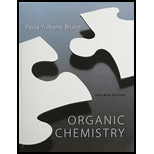
Concept explainers
(a)
Interpretation:
The products of
Concept Introduction:
For alkyl halide (tertiary, benzylic, and allylic) that can undergo both
A good nucleophile/strong base favors
In primary
In secondary alkyl halides substitution and elimination take place (strong. bulky bases and high temperatures favor elimination over substitution).
In tertiary alkyl halides only elimination takes place.
Allylic and benzylic halides substitution and elimination takes place (unless they are tertiary).
Tertiary alkyl halides, allylic halides and benzylic halides: substitution and elimination with substitution favored.
(b)
Interpretation:
The products of
Concept Introduction:
For alkyl halide (tertiary, benzylic, and allylic) that can undergo both
A good nucleophile/strong base favors
In primary alkyl halides substitution take place.
In secondary alkyl halides substitution and elimination take place (strong. bulky bases and high temperatures favor elimination over substitution).
In tertiary alkyl halides only elimination takes place.
Allylic and benzylic halides substitution and elimination takes place (unless they are tertiary).
Tertiary alkyl halides, allylic halides and benzylic halides: substitution and elimination with substitution favored.
(c)
Interpretation:
The products of
Concept Introduction:
For alkyl halide (tertiary, benzylic, and allylic) that can undergo both
A good nucleophile/strong base favors
In primary alkyl halides substitution take place.
In secondary alkyl halides substitution and elimination take place (strong. bulky bases and high temperatures favor elimination over substitution).
In tertiary alkyl halides only elimination takes place.
Allylic and benzylic halides substitution and elimination takes place (unless they are tertiary).
Tertiary alkyl halides, allylic halides and benzylic halides: substitution and elimination with substitution favored.
(d)
Interpretation:
The products of
Concept Introduction:
For alkyl halide (tertiary, benzylic, and allylic) that can undergo both
A good nucleophile/strong base favors
In primary alkyl halides substitution take place.
In secondary alkyl halides substitution and elimination take place (strong. bulky bases and high temperatures favor elimination over substitution).
In tertiary alkyl halides only elimination takes place.
Allylic and benzylic halides substitution and elimination takes place (unless they are tertiary).
Tertiary alkyl halides, allylic halides and benzylic halides: substitution and elimination with substitution favored.
Trending nowThis is a popular solution!

Chapter 10 Solutions
Organic Chemistry & Study Guide and Student Solutions Manual for Organic Chemistry, Books a la Carte Edition (7th Edition)
- The Hofmann product is favored by the E2 mechanism when 2-bromo-3-methylbutane is added: A. MeOH B. MeO:- in MeOH C. Nal in acetona D. (CH 3)3 CO:- in (CH 3),COHarrow_forwardDraw Sn1/E1 products of both reactions below or fill in the blank with appropriate stuffs for Sn1/E1arrow_forwardDraw the products of each SN1 reaction and indicate the stereochemistry when necessary.arrow_forward
- When 2-bromo-3-phenylbutane is treated with sodium methoxide, two alkenes result (by E2 elimination). The Zaitsevproduct predominates.(a) Draw the reaction, showing the major and minor products.(b) When one pure stereoisomer of 2-bromo-3-phenylbutane reacts, one pure stereoisomer of the major product results.For example, when (2R,3R)-2-bromo-3-phenylbutane reacts, the product is the stereoisomer with the methyl groups cis.Use your models to draw a Newman projection of the transition state to show why this stereospecificity is observedarrow_forwardWhen 2-bromo-3-phenylbutane is treated with sodium methoxide, two alkenes result (by E2 elimination). The Zaitsevproduct predominates.(a) Draw the reaction, showing the major and minor products.(b) When one pure stereoisomer of 2-bromo-3-phenylbutane reacts, one pure stereoisomer of the major product results.For example, when (2R,3R)-2-bromo-3-phenylbutane reacts, the product is the stereoisomer with the methyl groups cis.Use your models to draw a Newman projection of the transition state to show why this stereospecificity is observed.(c) Use a Newman projection of the transition state to predict the major product of elimination of (2S,3R)-2-bromo-3-phenylbutanearrow_forwardDraw the product of attached SN2 reaction and indicate stereochemistry.arrow_forward
- When 2-bromo-3-phenylbutane is treated with sodium methoxide, two alkenes result (by E2 elimination). The Zaitsevproduct predominates.(a) Draw the reaction, showing the major and minor productsarrow_forwardPlease fill out for each reaction i.Fill in the missing starting materials, products, or reagents as necessary.If no reaction occurs, write "N.R." and explain why this is the case. ii. Label each transformation as SN1, SN2, or acid/base. iii. Indicate if the product is racemic or a single enantiomer.arrow_forwarda.) Draw the reaction product for the following SN2 reaction b.) What is the best description of the product(s) that form? single enantiomer, achiral product, pair of enantiomers or pair of diastereomersarrow_forward
- This is Wittig Rxn: Whatever mechanism you choose to draw is fine since you can leave the base as B: Draw the arrow pushing mechanism using the compounds below – Constant: 4-nitrobenzyl benzaldehydebase 1: triethylaminebase 2: NaOHbase 3: K2CO3ylide: Acetonyltriphenylphosphonium chloridearrow_forwardGiven that an E2 reaction proceeds with anti periplanar stereochemistry, draw the products of each elimination. The alkyl halides in (a) and (b) are diastereomers of each other. How are the products of these two reactions related?arrow_forwardHow to Form an Internal Alkyne by Two Sequential SN2 Reactions ?arrow_forward
 Organic Chemistry: A Guided InquiryChemistryISBN:9780618974122Author:Andrei StraumanisPublisher:Cengage Learning
Organic Chemistry: A Guided InquiryChemistryISBN:9780618974122Author:Andrei StraumanisPublisher:Cengage Learning

